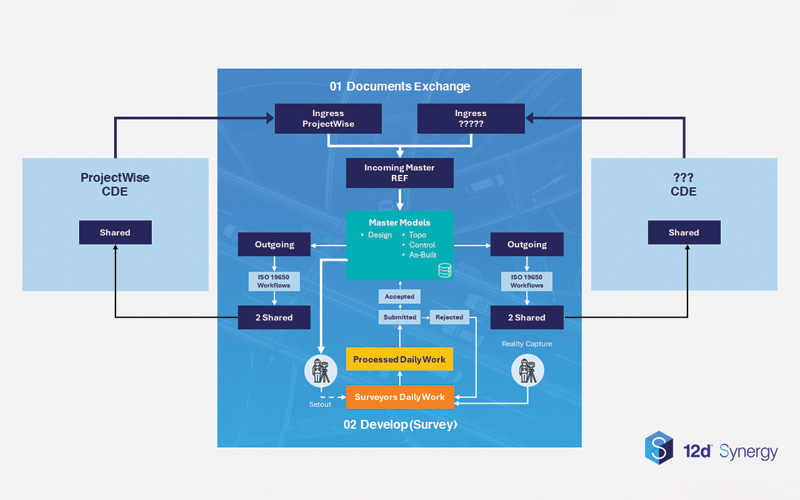Bridging the gap: Revolutionising Surveying with Common Data Environments (CDE)

Around four years ago, 12d Synergy took to the stage with a simple message: surveyors deserve better tools for managing data. They gave several presentations on Common Data Environments (CDE) for Surveyors. While civil infrastructure and engineering were evolving in digital delivery, survey teams were left managing ever-growing data volumes using outdated methods—USBs, Dropbox, and siloed systems.
Surveying is one of the most critical stages in the AEC lifecycle. It lays the foundation—literally—for design and construction. But until recently, the digital tools available to surveyors weren’t designed with their needs in mind. That’s where Common Data Environments (CDEs) purpose-built for surveying come in.
Understanding Common Data Environment for Surveying
What is a Common Data Environment for Surveying?
A Common Data Environment for Surveying is a system that provides an information management hub for all your surveying data. It is a tool that allows the surveying team to create, collaborate, and share information in a structured way.
We frequently engage with industry members, events, and partners to emphasise the necessity of an information management process, or Common Data Environment (CDE), tailored to the unique challenges of surveying. 12d Synergy has effectively addressed this gap by facilitating office-to-field collaboration. It has been the standard for surveying information management on major infrastructure projects across Australia and New Zealand for years.
The data-agnostic nature of 12d Synergy has enabled users to handle a variety of complex data sets. Beginning with 12d Model and 12d Field, we have seen 12d Synergy adopted in workflows for GIS databases.
How about beyond Australia and New Zealand?
Over the past two years, 12d has expanded its operations in the United Kingdom, including the market launch of 12d Synergy to the European Engineering and Construction industry. This market has shown a level of adoption and maturity around ISO 19650 that we have only recently started seeing domestically in civil infrastructure.
Why Surveyors Need Their Own Common Data Environment
- Surveyors deal with massive spatial datasets—point clouds, photos, GNSS data, drone scans, etc.—that aren’t easily managed in standard CDEs.
- On-site teams use a wide mix of hardware and software, especially subcontractors under BYOD agreements.
- Data transfer is often manual and inconsistent, leading to version errors and rework.
- Surveyors need real-time office-to-field collaboration to reduce site revisits and delays.
- Project CDEs focus on design/delivery files—not on survey-specific workflows, QA, or data capture metadata.

Addressing the Complex Challenges of Survey Data
With increased maturity, a wide range of tools in the digital engineering space now enhancing project information management practices (PIM), efficiency, and collaboration across construction teams. Despite this maturity, digital engineering leaders, survey managers, and information management practitioners continue to face the challenge of managing the vast array of complex data generated and managed within the surveying and GIS departments.
Surveyors aren’t just capturing data—they’re originating project-critical information. That data informs everything from design decisions to construction staking. But surveyors often struggle to manage, version, and share their outputs effectively because CDEs weren’t originally built for spatial or geospatial workflows.
This complex challenge presents itself in multiple ways:
- Complex data structures within project databases
- Common Data Environment (CDE) solutions focus more on project delivery and output file management, often overlooking managing workflows related to complex data sets.
- Disconnected or siloed CDEs across a project’s ecosystem, leading to inefficiencies and poor collaboration.
- A diverse range of hardware and software systems used by surveyors on-site, especially with subcontractors under BYOD agreements
- Unmanaged field-to-office workflows often relying on outdated methods like external hard drives, USB sticks, Dropbox, and email attachments.
- The growing volume and complexity of data in the surveying industry have resulted in larger data sets that are becoming increasingly difficult to manage and process efficiently on-site.
See how a universal CDE can revolutionise how you work, collaborate and drive efficiency.
Different approaches exist to create some form of ‘common’ practice and consolidate surveying information more efficiently.
One approach is to procure all systems and hardware as the lead appointing party or lead contractor. However, this poses a risk since your suppliers are professional data capture and geospatial service providers who have already invested in their own hardware and systems. Their business models and pricing structures account for these overheads. While this method can bring data together and potentially make it more accessible, it also leads to inefficiencies in the overall supply chain and duplicates costs.
Secondly, this solution may not effectively break down information silos between surveying and the broader project delivery team. Without carefully defining your requirements and processes, you risk merely shifting the data bottleneck further downstream rather than addressing the problem holistically.
At the other end of the spectrum is leveraging the existing investments made by your company and your suppliers. This involves adopting a data-agnostic Common Data Environment (CDE) for Surveying that adapts to your desired workflows rather than dictating them. The advantage of this approach is that it allows for the management of information creation and collaboration using the surveying processes you have already invested in. However, the downside is that a Surveying CDE often remains separate from the project’s core CDE, which can lead to the creation of information silos.
The ideal solution lies in finding a system that can exchange information between other systems on the project, creating a cohesive ecosystem.
Innovative Solutions for Surveyor’s Project Information Management
From this market, we have learned the broad application that 12d Synergy can have for surveyors, locators, and GIS professionals. 12d Synergy’s Digital Engineering Specialists based in the 12d UK, Tom Neighbours and Isaac Kennedy have mainly focused on further integrating 12d Synergy with a broader range of authoring software and related data sets in collaboration with our customers and other suppliers like Hexagon and Leica Geosystems.
The data sets in which 12d Synergy is managing beyond 12d Model and 12d Field includes Leica Captivate, Lecia Infinity, Carlson, Trimble Business Centre, LisCAD, BricsCAD, GIS, the AutoCAD family (e.g., Civil 3D), Inventor, and Revit.
12d Synergy’s ability to manage databases, files, and a project folder has provided a platform for surveying teams to hire surveyors with mixed fleet, software, and technical backgrounds/system preferences while providing a familiar, controlled environment for collaboration.
Surveying teams can engage in full ISO 19650–2 compliance by applying information management processes once the data is collected. 12d Synergy’s workflow engine allows master design models to be managed (including naming conventions, versions, revisions, and suitability codes) before being shared with surveying teams in the field, controlling the office-to-field workflow and collaboration.
For field-to-office functions, surveyors’ daily work is captured with version history. Submitted daily works are reviewed and approved accordingly and updated before being processed and shared with the broader team. 12d Synergy’s workflow engine manages all required metadata throughout this process.
The main priority of managing office-to-field and field-to-office is to provide the data managers with the right tools to ride the data tsunami that occurs regularly on major infrastructure jobs in a controlled, efficient way.

Key Features of a Surveyor-Focused CDE
- Data-Agnostic Workflows — Supports Leica Geosystems, Trimble, Carlson, LisCAD, 12d Model, and more
- Field-to-Office Sync — Offline syncing with full version control and approval workflows
- Geospatial Data Handling — Supports large datasets, coordinate systems, and spatial metadata
- QA/QC Workflows — Review and approve deliverables based on predefined rules
- BYOD Support — Let subcontractors use their own tools, while enforcing your standards
- ISO 19650 Readiness — Apply naming conventions, revisions, and suitability codes easily
The Importance of Breaking Down Data Silos
The recent addition of data flows is a crucial factor in 12d Synergy’s success. Data flows enable Surveyor’s Common Data Environment to seamlessly integrate with the broader CDE project, creating a cohesive Information Management ecosystem.
Popular CDE tools like Autodesk Construction Cloud (ACC) and ProjectWise connect to 12d Synergy through a two-way integration. This allows data sets and accompanying metadata to move between platforms per any approval processes set up by the workflow engine (e.g., Shared or Published gates).
The result is a data-agnostic Common Data Environment capable of managing a diverse range of surveying data and associated workflows, effectively breaking down information management silos.
If your survey team is juggling hard drives, email chains, and folder chaos, there’s a better way. Watch our webinar “Universal CDE for Contractors and Surveyors”, or book a tailored demo to see how 12d Synergy can streamline your surveying data workflows, from office to field and back.
Want real-world insights? Catch our industry session with Chris Staak from ESO Surveyors, where he shares what’s next for surveyors and how to stay ahead in a rapidly evolving data landscape.

